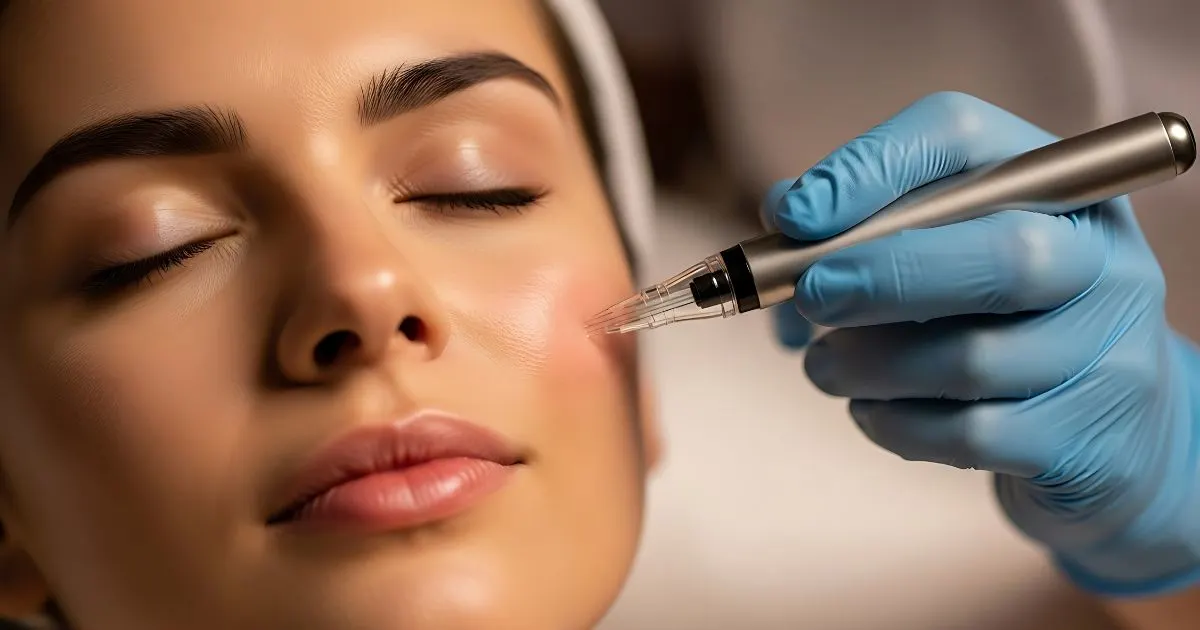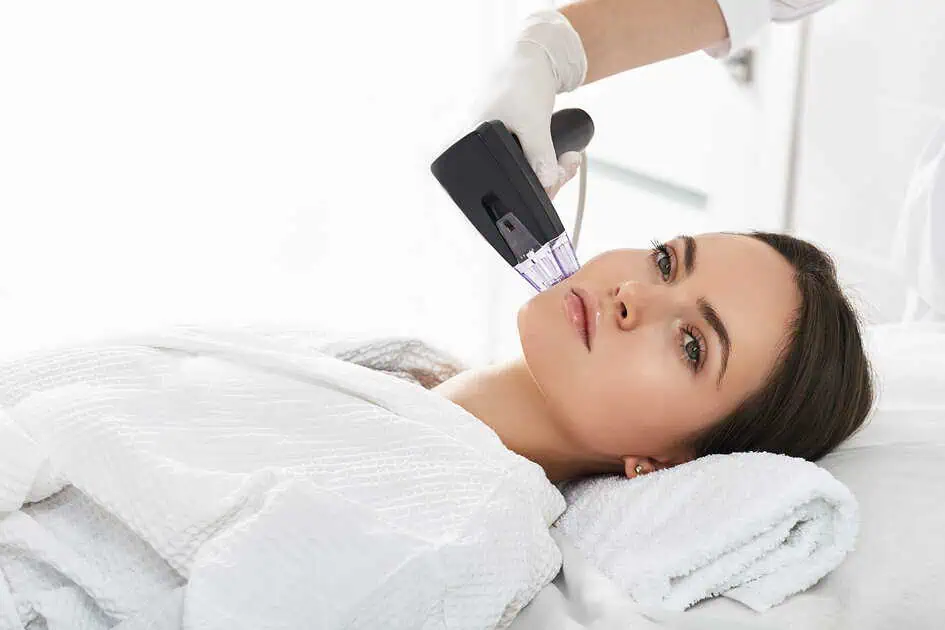
Dermaplaning is a straightforward exfoliation method that’s been getting more attention lately. It’s different from other exfoliation techniques because it uses a specific blade to gently remove dead skin and peach fuzz from your face. It’s simpler than it sounds – no harsh scrubs or chemicals. This method is becoming popular because it smooths and brightens the skin gently.
What is Dermaplaning?
Dermaplaning is a professional skincare treatment that focuses on exfoliating the face. It’s performed by a skilled aesthetician who uses a specialized, sterile surgical scalpel. The process involves the expert gently scraping the surface of the skin. This removes the outermost layer of dead skin cells and removes the fine vellus hair – the soft, translucent facial hair often referred to as peach fuzz.
What sets dermaplaning apart from other exfoliating treatments is its precision and gentleness. Unlike abrasive scrubs or chemical peels, it doesn’t irritate the skin. This makes it a great option for people with sensitive skin or those seeking a less aggressive rejuvenation method. Plus, it’s known for delivering immediate results – smoother, brighter skin that feels softer and provides a better base for makeup application. As a professional treatment, dermaplaning is tailored to the individual’s skin type and concerns, ensuring a personalized approach to skincare.
Comparison with Other Exfoliation Methods
Dermaplaning is a gentler, non-chemical exfoliation method that provides immediate results. It’s especially suited for those with sensitive skin or who prefer a physical exfoliation method that removes fine facial hair.
Dermaplaning vs. Mechanical Exfoliation:
Mechanical exfoliation methods, like scrubs, use small granules or brushes to physically remove dead skin cells. Dermaplaning, on the other hand, uses a blade for a more precise and even exfoliation. It’s gentler than most mechanical methods, which can sometimes be too abrasive, especially for sensitive skin.
Dermaplaning vs. Chemical Exfoliation:
Chemical exfoliants, such as alpha and beta hydroxy acids, dissolve dead skin cells. Dermaplaning provides a more immediate physical removal of dead skin cells without waiting for the chemicals to take effect. This can be preferable for those who are sensitive to acids or prefer a non-chemical approach.
Dermaplaning vs. Enzymatic Exfoliation:
Enzymatic exfoliation uses enzymes, usually from fruits, to gently break down dead skin cells. While enzymatic exfoliation is also gentle, dermaplaning offers the added benefit of removing peach fuzz along with dead skin cells, something that enzymatic methods do not address.
Unique Benefits of Dermaplaning
Dermaplaning brings unique benefits that set it apart from other skincare methods. These advantages cater to various skin care needs and preferences, offering more than just removing dead skin cells and peach fuzz.
- Enhanced Product Absorption: Post-dermaplaning, your skin can absorb skincare products more effectively, maximizing the benefits of your skincare routine.
- Reduction in the Appearance of Fine Lines: Regular dermaplaning can help reduce the appearance of fine lines, contributing to a more youthful look.
- Improves Skin Texture: Dermaplaning smooths the skin’s texture, making it feel softer and more even.
- Brightens Complexion: This method can brighten a dull complexion, giving the skin a more radiant appearance.
- No Downtime: Unlike some other facial treatments, dermaplaning doesn’t require downtime, so that you can resume your daily activities immediately.
- Suitable for Almost All Skin Types: It’s a versatile treatment that’s suitable for many, including those with sensitive skin.
- Makeup Application is Smoother: After dermaplaning, makeup glides on seamlessly, creating a flawless finish.
- Non-Invasive and Quick: The procedure is relatively quick and non-invasive, making it a convenient option for busy individuals.
Dermaplaning Procedure
When you go in for a dermaplaning session, you’ll first notice its simplicity and efficiency. Typically, the procedure begins with your skin being cleaned and prepped. This will be necessary to free your face of any dirt or oil that could interfere with the treatment.
Once your skin is ready, the aesthetician will use a sterile, surgical-grade scalpel. With skill and precision, they gently glide this tool across your skin at an angle. This action exfoliates the skin and removes fine hair. The process is surprisingly gentle and painless. Most clients describe it as a light scraping sensation that’s quite tolerable, even relaxing for some.
Throughout the procedure, the professional will pay close attention to your skin’s response, ensuring the process is as comfortable and practical as possible. The entire session usually takes around 30 minutes, making it a quick treatment option compared to other skincare procedures.
After the treatment, you can expect to see immediate results. Your skin will appear brighter and feel smoother. Unlike some other facial treatments, there’s no downtime with dermaplaning. You can return to your normal activities right away, albeit with a fresh, glowing complexion. The aesthetician might recommend a specific post-treatment skincare routine to maximize and maintain the results of the dermaplaning.
Dermaplaning Aftercare
After a dermaplaning treatment, follow a simple yet effective aftercare routine to maximize the treatment results. Your skin will be more sensitive to the sun, so applying a broad-spectrum sunscreen is crucial to protect it from UV damage. Avoiding direct sun exposure as much as possible for a few days is also recommended. Keep your skincare routine gentle and hydrating; avoid using harsh products or exfoliants immediately after the procedure. Hydrating serums and creams can help soothe and nourish your freshly exfoliated skin. Lastly, give your skin time to settle before applying makeup, ideally waiting at least a day to allow your skin to reap the full benefits of the treatment.
How Often Should You Try Dermaplaning?
For optimal results, it’s generally recommended to undergo dermaplaning treatments monthly. This frequency aligns well with the skin’s natural regeneration cycle, about every 30 days. Regular monthly sessions help maintain the smooth texture and radiant appearance achieved through dermaplaning. They also ensure consistent removal of dead skin cells and fine facial hair. By sticking to this schedule, you can keep your skin healthy and rejuvenated, maximizing the benefits of dermaplaning while allowing your skin ample time to recover between sessions.
Takeaway
Ready to experience the transformative benefits of dermaplaning for yourself? Don’t wait any longer! Contact Adam J. Cohen, MD, today and take the first step towards a healthier, more radiant complexion. Adam J. Cohen, MD, with his expertise and personalized approach, is dedicated to helping you achieve your skincare goals. Book your appointment now for your assessment and discover the difference that professional dermaplaning can make for your skin. Your journey to a brighter, smoother complexion starts here with Adam J. Cohen, MD!





